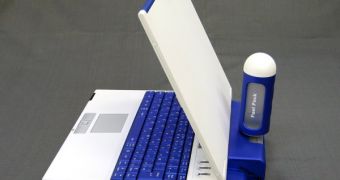Fuel cells differ from batteries in that they consume reactants, which must be replenished, while batteries store electrical energy chemically in a closed system. Additionally, while the electrodes within a battery react and change as a battery is charged or discharged, a fuel cell's electrodes are catalytic and relatively stable.
A fuel cell is an electrochemical energy conversion device. It produces electricity from external supplies of fuel (on the anode side) and oxidant (on the cathode side). These react in the presence of an electrolyte. Generally, the reactants flow in and reaction products flow out while the electrolyte remains in the cell. Fuel cells can operate virtually continuously as long as the necessary flows are maintained.
A new device developed by Chinese researchers, extracts by-products that normally impair the efficiency of "direct methanol" fuel cells (DMFCs), without requiring extra power. Electronics firms including Samsung and Toshiba are interested in using this type of fuel cell to power portable devices, since the conversion of methanol is potentially more efficient on this scale than using either hydrogen or standard batteries.
Researchers at National Tsing Hua University, Taiwan, have now developed a waste removal system that works without power, which could mean smaller DMFCs with more space for fuel. The new device acts like a filter, collecting gas and vapor in a few simple steps. Firstly, around a hundred 50-micron-wide holes, each coated with water-repelling Teflon, allow CO2 to escape into the surrounding air.
At the same time methanol and water vapor condense on the surface around the holes. The condensed liquid then flows 5 millimeters towards a reservoir for collection. A surface treated to repel water strongly at the start, and less so towards the collection point, pushes the liquid into the collection chamber. It can then be disposed of or recycled by extracting the methanol.
Although fuel cells can substitute for batteries, most manufacturers say they plan to use fuel cells to supplement batteries inside consumer electronic devices.
Fuel cells are very useful as power sources in remote locations, such as spacecraft, remote weather stations, large parks, rural locations, and in certain military applications. A fuel cell system running on hydrogen can be compact, lightweight and has no major moving parts. Because fuel cells have no moving parts, and do not involve combustion, in ideal conditions they can achieve up to 99.9999% reliability.
This equates to less than one minute of down time in a six year period, so fuel cells applications may represent a step forward in the small, portable power plants.

 14 DAY TRIAL //
14 DAY TRIAL //